
|
|
|
|
BY: SUN STAFF
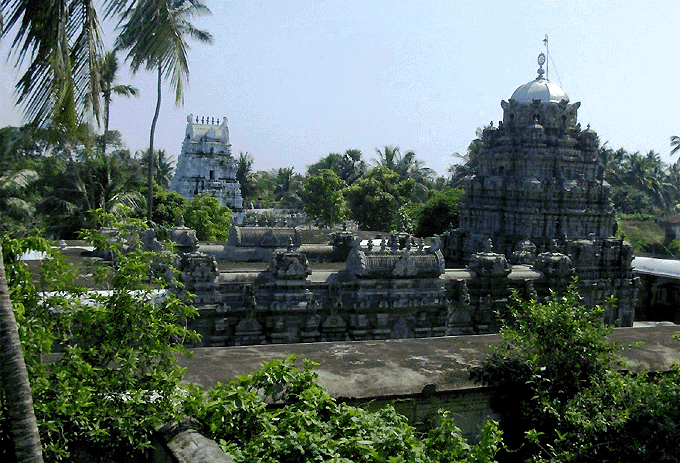
Srikurmam Temple Feb 21, CANADA (SUN) — A serial exploration of the holy sites visited by Lord Caitanya. Kurma-sthana
Today we resume our exploration of some of the individual tirthas Lord Caitanya Mahaprabhu visited during His South India pilgrimage. The holy site of Kurma-sthana is mentioned in the Summary of Sri Caitanya-caritamrta Madhya Lila 7:
"Sri Caitanya Mahaprabhu accepted the renounced order of life in the month of Magha (January-February) and went to Jagannatha Puri in the month of Phalguna (February-March). He saw the Dola-yatra festival during the month of Phalguna, and in the month of Caitra He liberated Sarvabhauma Bhattacarya. During the month of Vaisakha, He began to tour South India. When He proposed to travel to South India alone, Sri Nityananda Prabhu gave Him a brahmana assistant named Krsnadasa. When Sri Caitanya Mahaprabhu was beginning His tour, Sarvabhauma Bhattacarya gave Him four sets of clothes and requested Him to see Ramananda Raya, who was residing at that time on the bank of the river Godavari. Along with other devotees, Nityananda Prabhu accompanied the Lord to Alalanatha, but there Lord Caitanya left them all behind and went ahead with the brahmana Krsnadasa. The Lord began chanting the mantra "krsna krsna krsna krsna krsna krsna krsna he." In whatever village He spent the night, whenever a person came to see Him in His shelter, the Lord implored him to preach the Krsna consciousness movement. After teaching the people of one village, the Lord proceeded to other villages to increase devotees. In this way He finally reached Kurma-sthana. While there, He bestowed His causeless mercy upon a brahmana called Kurma and cured another brahmana, named Vasudeva, who was suffering from leprosy. After curing this brahmana leper, Sri Caitanya Mahaprabhu received the title Vasudevamrta-prada, meaning "one who delivered nectar to the leper Vasudeva."
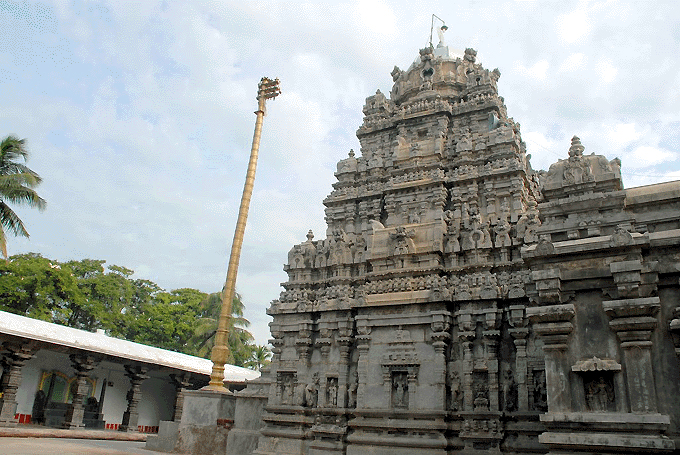
Kurma-sthana Later in Madhya Lila, Srila Prabhupada provides a great deal of detailed information about Kurma-sthana: Madya Lila 7.113 "When Lord Sri Caitanya Mahaprabhu came to the holy place known as Kurma-ksetra, He saw the Deity and offered prayers and obeisances. PURPORT: This holy place of Kurma-ksetra, or Kurma-sthana, was actually reestablished by Sripada Ramanujacarya under the influence of Lord Jagannatha-deva at Jagannatha Puri. Later the temple came under the jurisdiction of the king of Vijaya-nagara. The Deity was worshiped by the Vaisnavas of the Madhvacarya-sampradaya. In the temple there are some inscriptions said to be written by Sri Narahari Tirtha, who was in the disciplic succession of Madhvacarya. Srila Bhaktisiddhanta Sarasvati Thakura explains those inscriptions as follows: (1) Sri Purusottama Yati appeared as the instructor of many learned men. He was a very favorite devotee of Lord Visnu. (2) His preaching was accepted throughout the world with great respect, and by his power he would liberate many nondevotees with strong reason and logic. (3) He initiated Ananda Tirtha and converted many foolish men to accept sannyasa and punished them with his rod. (4) All his writings and words are very potent. He gave people devotional service to Lord Visnu so they could be elevated to liberation in the spiritual world. (5) His instructions in devotional service were able to elevate any man to the lotus feet of the Lord. (6) Narahari Tirtha was also initiated by him, and he became the ruler of the Kalinga province. (7) Narahari Tirtha fought with the Sabaras, who were candalas, or hunters, and thus saved the temple of Kurma. (8) Narahari Tirtha was a very religious and powerful king. (9) He died in the Saka Era 1203, in the month of Vaisakha in the fortnight of the moon's waxing period, on the day of Ekadasi, after the temple was constructed and dedicated to the holy name of Yogananda Nrsimhadeva. The tablet is dated A.D. 1281, 29 March, Saturday." In attempting to pinpoint Kurma-sthana on current maps, we find that it takes a bit of searching. There are few modern references to the place name 'Kurma-sthana' or 'Kurma-shetra', although Srila Prabhupada's reference to Teluga points us to Andhra Pradesh, where Teluga is the official language. Commonly known today as Srikurmam, the famous temple of Lord Kurma is situated in Andhra Pradesh, about 100 km northeast of Visakhapatnam and 200 km southwest of Puri, on the shore of the Bay of Bengal, 15 km east of the town of Srikakulam. Srikakulam sits at the extreme south of the Taluk, very near the coast. Today, pilgrims coming to the tirtha ride the Madras-Calcutta line of Southern Railway, disembarking at the Srikakulam Railway Station, then taking a bus or taxi from Srikakulam to Srikurmam. There are few facilities available in Srikurmam village, as the temple of Kurma Avatara is the primary presence there. There original temple is said to be have been built in 200 A.D., although the present structure is about 700 years old.
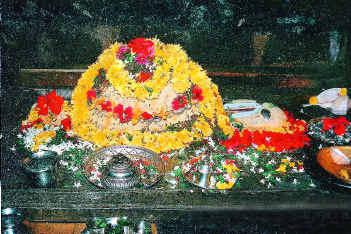
Sri Kurmam The presiding Deity, Lord Kurma is self-manifest, or svayambhu. He is about 70 cm long, shaped like the shell of a turtle. The Deity's tail is a salagram presented by Adi Sankar. Inside the garbha-griha, or sanctum sanctorum, Sri Kurmam is joined by Deities of Govindaraja (Krsna) with Rukmini and Satyabhama on one side, and Sita, Rama and Laksman on the other side. The temple architecture is a blend of Orissan and Dravidian styles. Inside there are many beautiful carvings of Lord Visnu and other transcendental personalities. The mandapam in front of the temple sits upon lion pillars. There are dwajastamba pillars both in the front and back of the temple, which is quite unusual. This is because the Deity faces the back of the temple, to the west. Although deities are often facing east, Lord Kurma faces west due to the pastimes of the great Vaisnava saint, Bilvamangala Thakur. He prayed to the Lord so fervently while leaning against the west wall, at the temple entrance, that the Deity of Lord Kurma turned His head to look at His devotee. Bilvamangala Thakura's samadhi is located in the Kurma-sthana temple complex, to the left of the main temple, and his body is said to be in samadhi beneath it the temple. Bilvamangala Thakur's murti is four-armed, as he is understood to be an associate of the Lord and a resident of Vaikuntha.
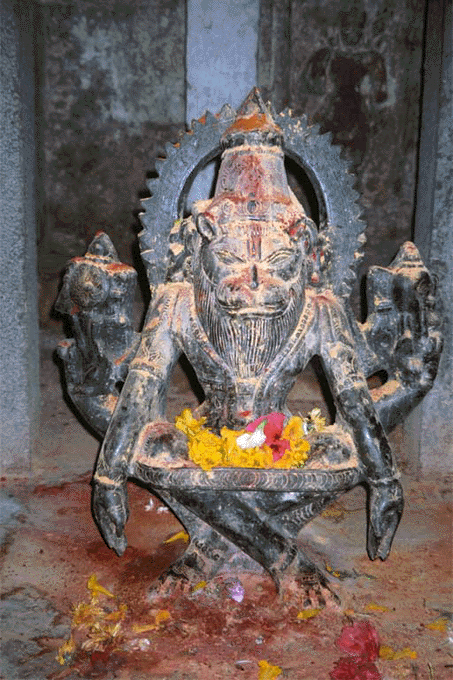
Sri Yoga-Nrsimhadev Also residing at Kurma-sthana is a beautiful Yogananda Nrsimhadev, which is worshipped by sadhus in the Madhvacarya line. The temple sits to the east of a theertham called Swathi puskarini. Sitting atop a small hill at Kurma-ksetra there is a shrine which houses the Lotus Footprints of Sri Caitanya Mahaprabhu, who visited the spot in 1512. This pada-tirtha was established in December 1930 by Srila Bhaktisiddhanta Saraswati Thakur. There is a big festival at Kurma-ksetra each year, in mid-February, commemorating Lord Caitanya's visit to the temple in 1512.
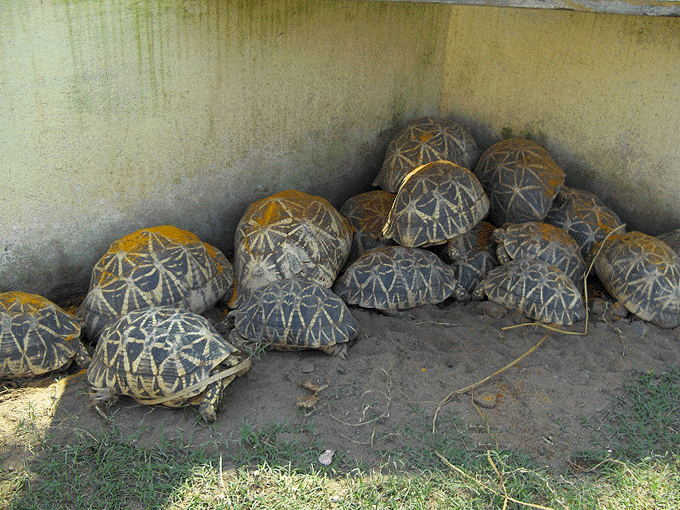
Group of Tortise at Kurma-ksetra Navadvipa Dhama Mahatmya by BVT In the following excerpt from Srila Bhaktivinoda Thakur's Navadvipa Dhama Mahatmya, Parikrama-khanda, Chapter Fifteen, Nityananda Prabhu is relating the glories of the Lord to Sri Jiva Goswami. In this story about Ramanujacarya, his preaching base at Kurma-sthana is mentioned, and we get a further description of the gaura-lila influence that permeated Ramanuja's later preaching in South India: "There is one more confidential story. Ramanujacarya once came to Puri and pleased the Lord with many prayers. Jagannatha appeared before him and said, 'Go and see Navadvipa-dhama, for I will soon appear there in the house of Jagannatha Misra. The entire spiritual sky is situated within one corner of Navadvipa, My very dear abode. As My eternal servant and leading devotee, you should see Navadvipa. Let your students, who are absorbed in dasya-rasa, stay here while you go. Any living being who does not see Navadvipa has been born uselessly. Just one portion of Navadvipa contains Ranga-ksetra. Sri Venkata (Tirupati), and Yadava Acala. O son of Kesava go to Navadvipa and see the form of Gauranga. You have come to the earth to teach bhakti, so let your birth be successful with the mercy of Gaura. From Navadvipa, go to Kurma-sthana and join again with your disciples.' "With folded hands, Ramanuja submitted to Jagannatha, 'In Your narration You have mentioned Gauracandra, but exactly who He is, I do not know. "The Lord mercifully replied to Ramanuja, 'Everyone knows Krsna, the Lord of Goloka. That Krsna, whose vilasa-murti is Narayana, is the Supreme Truth, and He resides in Vrndavana. That Krsna is fully manifest in the form of Gaurahari, and that Vrndavana is fully manifest in the form of Navadvipa-dhama. I eternally reside as Lord Gauranga in Navadvipa, the topmost abode in the universe. By My mercy that dhama has come within Bhu-mandala, yet it remains without a scent of maya. This is the verdict of scripture. If you say that Navadvipa is part of the material world, then your devotion will dwindle day by day. I have placed this spiritual abode within the material world by My desire and inconceivable energy. Simply by reading scriptures one will not get the highest truth, for the highest truth surpasses all reasoning power. Only the devotees can understand by My mercy. ''Hearing this, the sober-minded Ramanuja was agitated with love for Gauranga. He said, 'Lord, Your pastimes are truly astounding. The scriptures cannot know Your opulences. Why isn't gauranga-lila clearly described in the scriptures? When I closely examine the sruti and Puranas, I find only some hint of the Gaura-tattva. After hearing your instructions, my doubts are gone and the sweet mellows of Gauranga's pastimes have arisen in my heart. If You order me, after going to Navadvipa, I will preach gaura-lila throughout the three worlds. I will give people evidence from the hidden scriptures and establish devotional service to Gauranga throughout the universe. Please instruct me. "Seeing Ramanuja's eagerness, Jagannatha said, 'Ramanuja, do not broadcast like this. Keep the confidential pastimes of Gauranga secret. Only after Gauranga has finished His pastimes will the general public receive them. For now, preach dasya-rasa, while in your heart worship Gauranga constantly. "Taking the Lord's advice, Ramanuja secretly cultured his attraction for Navadvipa. So that Gauranga's pastimes were not revealed prematurely, Lord Narayana then led Ramanuja here to Vaikunthapura and mercifully showed Ramanuja His transcendental form served by Sri, Bhu, anti Nila. Ramanuja considered himself fortunate to obtain darsana of his worshipable Lord, when suddenly he saw the Lord assume the enchanting form of Gaurasundara, the son of Jagannatha Misra. Ramanuja swooned at the brilliance of the form. Then Gauranga put His lotus feet on the head of Ramanuja, who was thus divinely inspired and recited prayers of praise. 'I must see Gaura's actual lila on earth. I can never leave Navadvipa!' "Gauranga said, 'O son of Kesava, your desire will be fulfilled. When the Nadia pastimes will be revealed in the future, you will take birth here again. "Gauranga disappeared and Ramanuja, contented, resumed his journey. After some days he arrived at Kurma-sthana and saw the place with his disciples. During his life he preached dasya-rasa throughout South India, while internally he was absorbed in gaura-lila. By Gauranga's mercy, he took birth in Navadvipa as the devotee Sri Ananta."
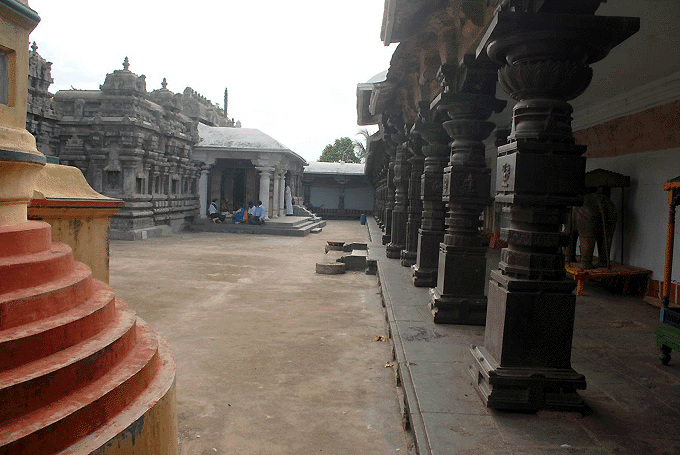
Temple Courtyard
| |